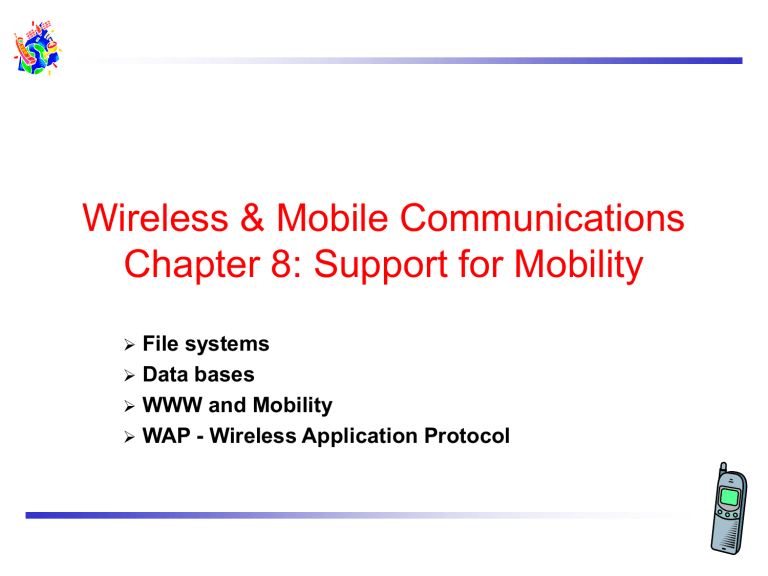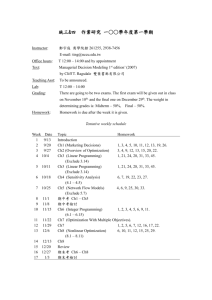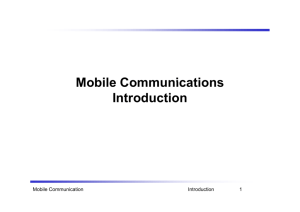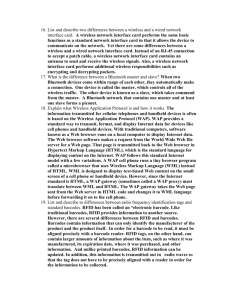Mobile Communications

Wireless & Mobile Communications
Chapter 8: Support for Mobility
File systems
Data bases
WWW and Mobility
WAP - Wireless Application Protocol
File systems - Motivation
Goal
efficient and transparent access to shared files within a mobile environment while maintaining data consistency
Problems
limited resources of mobile computers (memory, CPU, ...)
low bandwidth, variable bandwidth, temporary disconnection high heterogeneity of hardware and software components (no standard PC architecture) wireless network resources and mobile computer are not very reliable standard file systems (e.g., NFS, network file system) are very inefficient, almost unusable
Solutions
replication of data (copying, cloning, caching) data collection in advance (hoarding, pre-fetching)
Ch8 - Mobility Support Winter 2001 8.2
File systems - consistency problems
THE main problem of distributed, loosely coupled systems
are all views of the data the same?
how and when should changes be propagated and to which users?
Weak consistency
many algorithms offering strong consistency (e.g., via atomic updates
(locking the data file, updating caches after a lock is released)) cannot be used in mobile environments
Updating of invalid data located in caches by a central server is very problematic if the mobile computer is currently not connected to the network weak consistency consists of having to live with invalid data for short durations of time means that occasional inconsistencies have to be tolerated, but conflict resolution strategies must be applied afterwards to reach consistency again
Conflict detection
content independent: version numbering, time-stamps content dependent: dependency graphs
Ch8 - Mobility Support Winter 2001 8.3
Database systems in mobile environments
Request processing
power conserving, location dependent, cost efficient example: find the fastest way to a hospital
Replication management
similar to file systems
Location management
tracking of mobile users to provide replicated or location dependent data in time at the right place (minimize access delays) example: with the help of the HLR (Home Location Register) in
GSM a mobile user can find a local towing service
Transaction processing
“mobile” transactions can not necessarily rely on the same models as transactions over fixed networks (ACID: atomicity, consistency, isolation, durability) therefore models for “weak” transaction
Ch8 - Mobility Support Winter 2001 8.4
World Wide Web and mobility
Protocol (HTTP, Hypertext Transfer Protocol) and language
(HTML, Hypertext Markup Language) of the Web have not been designed for mobile applications and mobile devices, thus creating many problems!
Typical transfer sizes
HTTP request: 100-350 byte responses avg. <10 kbyte, header 160 byte, GIF 4.1kByte,
JPEG 12.8 kbyte, HTML 5.6 kbyte but also many large files that cannot be ignored
The Web is no file system
Web pages are not simple files to download
static and dynamic content, interaction with servers via forms, content transformation, push technologies etc.
many hyperlinks, automatic loading and reloading, redirecting a single click might have big consequences!
Ch8 - Mobility Support Winter 2001 8.5
HTTP 1.0 and mobility I
Characteristics
stateless, client/server, request/response needs a connection oriented protocol (TCP), one connection per request (some enhancements in HTTP 1.1) primitive caching and security
Problems
designed for large bandwidth (compared to wireless access) and low delay large and redundant protocol headers (readable for humans, stateless, therefore large headers in ASCII) uncompressed content transfer using TCP huge overhead per request (3-way-handshake) compared with the content, e.g., of a GET request slow-start problematic as is without having to deal with the wireless problem
DNS lookup by client causes additional traffic and delays
Ch8 - Mobility Support Winter 2001 8.6
HTTP 1.0 and mobility II
Caching
quite often disabled by information providers to be able to create user profiles, usage statistics etc.
dynamic objects cannot be cached numerous counters, time, date, personalization, ...
mobility quite often inhibits caches security problems caches cannot work with authentication mechanisms that are contracts between client and server and not the cache today: many user customized pages, dynamically generated on request via CGI, ASP, ...
POSTing (i.e., sending to a server)
can typically not be buffered, very problematic if currently disconnected
Many unsolved problems!
Ch8 - Mobility Support Winter 2001 8.7
HTML and mobile devices
HTML
designed for computers with “high” performance, color highresolution display, mouse, hard disk
typically, web pages optimized for design, not for communication
Mobile devices
often only small, low-resolution displays, very limited input interfaces (small touch-pads, soft-keyboards)
Additional “features”
animated GIF, Java AWT, Frames, ActiveX Controls,
Shockwave, movie clips, audio, ...
many web pages assume true color, multimedia support, highresolution and many plug-ins
Web pages ignore the heterogeneity of end-systems!
e.g., without additional mechanisms, large high-resolution pictures would be transferred to a mobile phone with a lowresolution display causing high costs
Ch8 - Mobility Support Winter 2001 8.8
Approaches toward a WWW for mobile devices
Application gateways, enhanced servers
simple clients, pre-calculations in the fixed network
Compression, transcoding, filtering, content extraction automatic adaptation to network characteristics
Examples
picture scaling, color reduction, transformation of the document format (e.g., PS to TXT)
Present only parts of the image: detail studies, clipping, zooming headline extraction, automatic abstract generation
HDML (handheld device markup language): simple language similar to
HTML requiring a special browser, developed by Unwired Planet
HDTP (handheld device transport protocol): transport protocol for
HDML, developed by Unwired Planet
Problems
proprietary approaches, require special enhancements for browsers heterogeneous devices make approaches more complicated
Ch8 - Mobility Support Winter 2001 8.9
Some new issues that might help mobility?
Push technology
real pushing, not a client pull needed, channels etc.
HTTP/1.1
client/server use the same connection for several request/response transactions multiple requests at beginning of session, several responses in same order enhanced caching of responses (useful if equivalent responses!) semantic transparency not always achievable: disconnected, performance, availability -> most up-to-date version...
several more tags and options for controlling caching
(public/private, max-age, no-cache, etc.) encoding/compression mechanism, integrity check, security of proxies, authentication, authorization...
Cookies: well..., stateful sessions, not really integrated...
Ch8 - Mobility Support Winter 2001 8.10
System support for WWW in a mobile world I
Enhanced browsers
Pre-fetching, caching, off-line use e.g. Internet Explorer mobile client browser integrated enhancement web server
Ch8 - Mobility Support Winter 2001 8.11
System support for WWW in a mobile world II
mobile client
Client Proxy
Pre-fetching, caching, off-line use e.g., Caubweb, TeleWeb, Weblicator,
WebWhacker, WebEx, WebMirror,
...
browser web server client proxy
Ch8 - Mobility Support Winter 2001 8.12
System support for WWW in a mobile world III
Client and network proxy
combination of benefits plus simplified protocols e.g., MobiScape, WebExpress mobile client browser web server
Special network subsystem
adaptive content transformation for bad connections, pre-fetching, caching e.g., Mowgli mobile client browser client proxy network proxy client proxy
Additional many proprietary server extensions possible
“channels”, content negotiation, ...
Ch8 - Mobility Support Winter 2001 web server network proxy
8.13
WAP - Wireless Application Protocol
Goals
deliver Internet content and enhanced services to mobile devices and users (mobile phones, PDAs) independence from wireless network standards open for everyone to participate, protocol specifications will be proposed to standardization bodies applications should scale well beyond current transport media and device types and should also be applicable to future developments
Platforms
e.g., GSM (900, 1800, 1900), CDMA IS-95, TDMA IS-136, 3 rd generation systems (IMT-2000, UMTS, W-CDMA)
Forum
WAP Forum, co-founded by Ericsson, Motorola, Nokia,
Unwired Planet further information http://www.wapforum.org
Ch8 - Mobility Support Winter 2001 8.14
WAP - scope of standardization
Browser
“micro browser”, similar to existing, well-known browsers in the Internet
Script language
similar to Java script, adapted to the mobile environment
WTA/WTAI
Wireless Telephony Application (Interface): access to all telephone functions
Content formats
e.g., business cards (vCard), calendar events (vCalender)
Protocol layers
transport layer, security layer, session layer etc.
Working Groups
WAP Architecture Working Group, WAP Wireless Protocol
Working Group, WAP Wireless Security Working Group, WAP
Wireless Application Working Group
Ch8 - Mobility Support Winter 2001 8.15
WAP - reference model and protocols
Internet
HTML, Java
HTTP
SSL/TLS
TCP/IP,
UDP/IP, media
A-SAP
WAP
Application Layer (WAE)
S-SAP
Session Layer (WSP)
TR-SAP
Transaction Layer (WTP)
SEC-SAP
Security Layer (WTLS) additional services and applications
T-SAP
Transport Layer (WDP)
WCMP
Bearers (GSM, CDPD, ...)
WAE comprises WML (Wireless Markup Language), WML Script, WTAI etc.
Ch8 - Mobility Support Winter 2001 8.16
WAP - network elements
fixed network
Internet
HTML web server
HTML
HTML filter
WML WAP proxy
WML
HTML filter/
WAP proxy wireless network
Binary WML
Binary WML
WTA server
Binary WML
PSTN
Ch8 - Mobility Support
Binary WML: binary file format for clients
Winter 2001 8.17
WDP - Wireless Datagram Protocol
Protocol of the transport layer within the WAP architecture
uses directly transport mechanisms of different network technologies offers a common interface for higher layer protocols allows for transparent communication using different transport technologies if IP is used, then WDP more or less translates to UDP
Goals of WDP
create a worldwide interoperable transport system with the help of WDP adapted to the different underlying technologies transmission services such as SMS in GSM might change, new services can replace the old ones
Ch8 - Mobility Support Winter 2001 8.18
WTLS - Wireless Transport Layer Security
Goals
data integrity prevention of changes in data privacy prevention of tapping authentication creation of authenticated relations between a mobile device and a server protection against denial-of-service attacks protection against repetition of data and unverified data
WTLS
is based on the TLS (Transport Layer Security) protocol
(former SSL, Secure Sockets Layer) optimized for low-bandwidth communication channels
Ch8 - Mobility Support Winter 2001 8.19
WTP - Wireless Transaction Protocol
Goals
different transaction services, offloads applications application can select reliability, efficiency support of different communication scenarios class 0: unreliable message transfer class 1: reliable message transfer without result message class 2: reliable message transfer with exactly one reliable result message supports peer-to-peer, client/server and multicast applications low memory requirements, suited to simple devices (< 10kbyte ) efficient for wireless transmission segmentation/reassembly selective retransmission header compression optimized connection setup (setup with data transfer)
Ch8 - Mobility Support Winter 2001 8.20
WSP - Wireless Session Protocol
Goals
HTTP 1.1 functionality
Request/reply, content type negotiation, ...
support of client/server, transactions, push technology key management, authentication, Internet security services session management (interruption, resume,...)
Services
session management (establish, release, suspend, resume) capability negotiation content encoding
WSP/B (Browsing)
HTTP/1.1 functionality - but binary encoded exchange of session headers push and pull data transfer asynchronous requests
Ch8 - Mobility Support Winter 2001 8.21
WAE - Wireless Application Environment
Goals
network independent application environment for low-bandwidth, wireless devices integrated Internet/WWW programming model with high interoperability
Requirements
device and network independent, international support
manufacturers can determine look-and-feel, user interface considerations of slow links, limited memory, low computing power, small display, simple user interface (compared to desktop computers)
Components
architecture: application model, browser, gateway, server
WML: XML-Syntax, based on card stacks, variables, ...
WMLScript: procedural, loops, conditions, ... (similar to JavaScript)
WTA: telephone services, such as call control, text messages, phone book, ... (accessible from WML/WMLScript) content formats: vCard, vCalendar, Wireless Bitmap, WML, ...
Ch8 - Mobility Support Winter 2001 8.22
WAE logical model
Origin Servers web server
Gateway response with content encoders
& decoders other content server push content request encoded response with content
Client
WTA user agent
WML user agent encoded push content other
WAE user agents encoded request
Ch8 - Mobility Support Winter 2001 8.23
Wireless Markup Language (WML)
WML follows deck and card metaphor
WML document consists of many cards, cards are grouped to decks a deck is similar to an HTML page, unit of content transmission
WML describes only intent of interaction in an abstract manner presentation depends on device capabilities
Features
text and images
user interaction navigation context management
Ch8 - Mobility Support Winter 2001 8.24
Examples for WAP protocol stacks
WAP standardization
WAE user agent
WAE
WSP
WTP
WTLS transaction based application
WTP
WTLS outside WAP datagram based application
WTLS
UDP WDP
IP
(GPRS, ...) non IP
(SMS, ...)
1.
typical WAP application with complete protocol stack
Ch8 - Mobility Support
UDP WDP
IP
(GPRS, ...) non IP
(SMS, ...)
2.
Winter 2001
UDP WDP
IP
(GPRS, ...) non IP
(SMS, ...)
3.
pure data application with/without additional security
8.25








